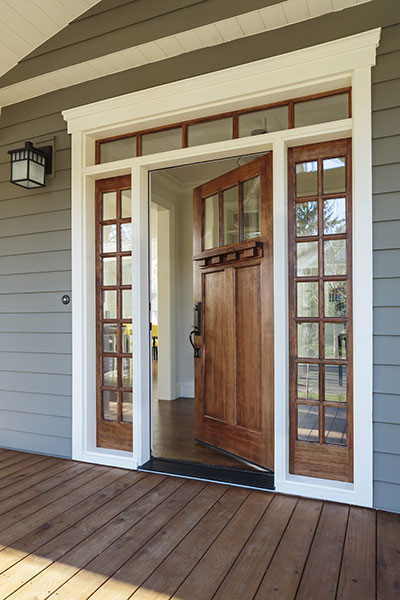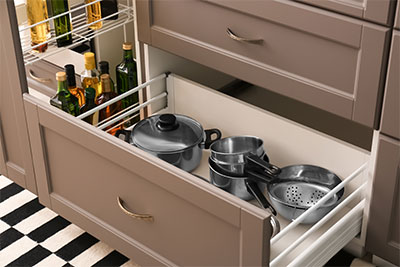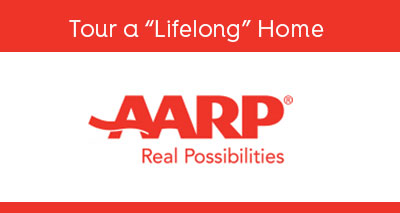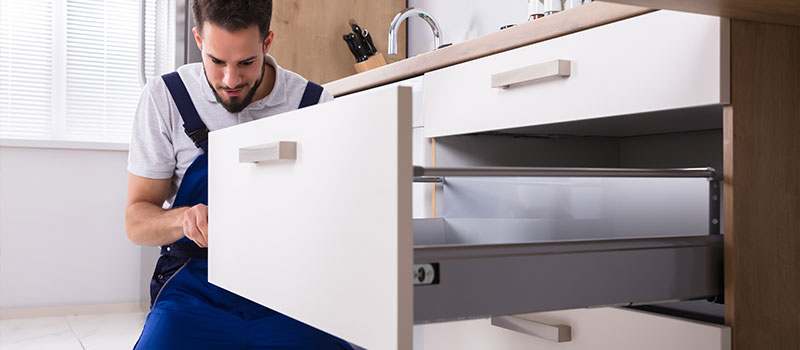
Accessible residential features such as no-step entryways and wide doorways are common elements in universal design as they serve a variety of users and are adaptable to a variety of conditions.
How it Works
Residential universal design serves individuals of all ages and abilities by standardizing accessible features such as no-step entryways, one-story living, open floor plans, ramps, wider doorways and hallways, varied counter heights, soft-closing drawers and cabinets, automated lighting, lever-style handles, rocker panel switches, and non-slip surfaces. These features serve all residents, age groups, levels of physical ability, and health status.
Municipalities can implement universal design through promoting universal design concepts in long range planning and through potential revisions to building codes to request universal design features in certain types of residential dwellings. For information regarding universal design for public spaces, see Universal Design for Public Spaces.
The Center for Universal Design offers seven principles of universal design which can be applied to residential uses:
1. Equitable use
The design of residential buildings should be accessible for all uses. For example, a no-step entryway into a home.
2. Flexible use
Residential features should be adaptable to all users, such as a countertop that can be used from either a seated or standing position.
3. Intuitive use
Intuitive design features promote simplicity of use, such as a rocker panel light switch which can quickly and easily be turned on or off.
4. Perceptible information
Perceptible information simplifies tasks for all users. An example is a thermostat with enlarged visual information, tactile design, and high-contrast colors.
5. Tolerance for error
Design features can accommodate tolerance for error to provide safety features which limit the chance of harm for users. An example of this is locating a microwave at waist level so users are not at risk of dropping hot food on themselves.
6. Low physical effort
Universal design in residential uses should promote design features which allow for efficient and comfortable use for all users while limiting fatigue. For example, lever-style handles in place of door knobs may be operated with a range of motions, such as with an elbow or a closed fist.
7. Size and space for approach and use
Residences should be designed with respect to users of all body sizes, postures, and means of mobility. Examples of this include open floor plans which permit wide turning motions for those in wheelchairs, or open areas for children to play while their caretaker can look on from another room.

The incorporation of universal design features in residences accommodates a number of life circumstances, such as aging in place.
Benefits
Multi-generational use
Homes designed with universal design features are comfortable and accommodating to all users and age ranges. These design features may be equally attractive to young children, adults of all abilities, and the elderly. Residences with universal design features would allow for multiple generations to live in the same home.
Aging in place
Universal design features may help residents to stay in their home as they age rather than relocating. Universal design features help promote independence and limit risk of accident or injury.
Adaptability
Many features of universal design are designed for the lifetime of residents through accommodating changing housing needs. The inclusion of universal design features such as wider doorways, no-step entryways, safe surfaces, and open floorplans is adaptable for future needs of residents such as the birth of a child, injury, illness, and aging.
Cost efficiency
The cost of adding universal design features to new construction is relatively low. While retrofitting universal design features into existing structures requires a greater expense, these features often present lasting value as they better accommodate all life stages and circumstances. Integrating these features may be cost effective when done incrementally, such as replacing door knobs with door handles.
Resource conservation
Designing or retrofitting a home for all life circumstances helps defer new greenfield development, thereby conserving and protecting valuable natural resources. The use of existing housing stock reduces the need to expend energy in new construction.


Universal design features in kitchens promote convenient and safe use by all uses, including pull-out cabinetry and location of stove controls near waist level to prevent injury. Other examples of kitchen universal design features can be found at AARP.
Get Started
Municipalities can promote universal design, by highlighting the need for residential universal design for the advancement of public health in community comprehensive plans. Other non-regulatory options which can be used to share universal design concepts and benefits include public education outlets such as municipal websites, newsletters, and social media.
Municipalities have limited regulatory control over the inclusion of universal design features through their zoning and subdivision ordinances because these ordinances do not typically address interior building standards. However, municipalities can encourage opportunities for universal design in building codes and zoning and land development ordinances which establish standards for residential uses. Zoning and land development provisions should be evaluated to encourage and permit design features which promote the goals of universal design and to ensure that universal design features are not precluded based on current standards. Examples of features to evaluate through building code regulations include: step-free entrances, wider interior doors on the ground floor, accessible first-floor bathrooms, maximum slopes, and, setback relief for Americans with Disabilities Act building components. Municipalities interested in promoting universal design for residential uses may want to consider requiring universal design features in age restricted communities, multi-story apartment homes, and condominium buildings.
Municipalities benefit from promoting universal design as it serves individuals of all populations and age ranges while creating accessible communities. Universal design accommodates the growing need and desire of residents to age in place. Outside of the home, municipalities should encourage Universal Design Features for Public Spaces. Communities with universally designed homes and public spaces contribute to accessible and aging friendly communities.
Considerations
Cultural familiarity
Although universal design features can be attractive in design, consumers may be unaware of their advantages and purpose potentially limiting the marketability of these features. Residential developers may be hesitant to include universal design features, fearing that consumers may find them unusual or unnecessary.
Demand for social services
While universal features supports aging in place and may be beneficial for those with disabilities, these individuals may still require significant social services. Social services should continue to be advertised throughout the community to ensure that residents receive the care that they need.
Inclusive design
Incorporating design features which span the full needs of residents of all ages and abilities can be challenging. Care should be taken to ensure that design features appeal to diverse needs of residents and that these features are planned in a manner which limits conflicting intentions.
Outreach
Promoting universal design requires communication between the community and a number of professionals in the fields of accessibility, planning, construction, and engineering. Means should be taken to transfer information between the residential community and development professionals to ensure community needs are met.
Regulatory limitations
While other states have passed legislation which requires housing to be built to universal design standards, these requirements are not always reflected in local zoning and building codes. Under the Pennsylvania Universal Accessibility Standards, certain buildings such as apartment homes, multistory condominium complex, and nursing homes may be required to include accessible and adaptable features at their time of construction or major renovation.
Development cost
While the incremental addition of universal design features in existing homes is generally cost effective, developers may be concerned with the potential cost of the total inclusion these features in new construction. Additionally, major and costly renovations may be necessary for residences that are not compatible with or not originally designed with universal design features in mind.

Universal Design: Comprehensive Plan
Landscapes3 identifies universal design as a priority in community planning and provides information on the importance of promoting universal design in housing and public spaces. A number of community partners knowledgeable in universal design and aging in place are identified and community partnership is encouraged. Chester County municipalities can further promote the principles of universal design through their own community comprehensive plans which can address specific opportunities and concerns in the community.

AARP: Tour a "Lifelong" Home
The "Lifelong Home" contains a number of features which are effective for permitting aging in place. Universal features include wheelchair accessible doorways and turning radii, lower countertops, storage solutions such as pull-out cutting boards and a stove with controls on the front.


